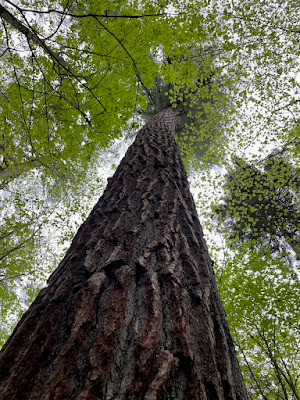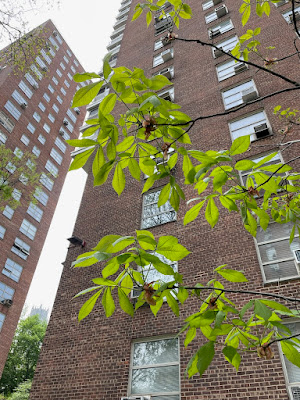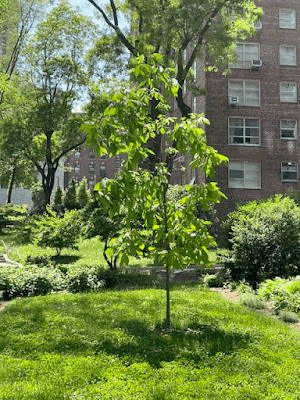Friday, May 31, 2024
Lost in the idea of woods
Thursday, May 30, 2024
Wednesday, May 29, 2024
Parentage of beauty
.jpeg) Back in my office again for the first time in a spell, I reread Buddhist poet W. S. Merwin's enchanting Unchopping a Tree, appreciating anew the lovely illustrations of Liz Ward. The poem, which isn't perhaps really about trees at all, offers instructions on undoing the destruction of a felled tree, starting with refastening leaves which fell off, then slowy hoisting the trunk back into place. This is where the chips which the chainsaw sent flying are restored to their original places...
Back in my office again for the first time in a spell, I reread Buddhist poet W. S. Merwin's enchanting Unchopping a Tree, appreciating anew the lovely illustrations of Liz Ward. The poem, which isn't perhaps really about trees at all, offers instructions on undoing the destruction of a felled tree, starting with refastening leaves which fell off, then slowy hoisting the trunk back into place. This is where the chips which the chainsaw sent flying are restored to their original places...
Tuesday, May 28, 2024
Lights, camera

Went back to The New School for the first time in almost two months to find the courtyard transformed! The lush new planting regime is getting lusher and lusher, rich greens coming from above and below. The transformation is almost cinematic! Then came a delicious
 surprise. A string of people dressed like folks from the glory days of The New School in the 1940 started to flow across the courtyard. Turns out someone was shooting a movie scene in the big auditorium, and the extras had to cross the courtyard to pick up their lunches. Past and present blurred for a moment.
surprise. A string of people dressed like folks from the glory days of The New School in the 1940 started to flow across the courtyard. Turns out someone was shooting a movie scene in the big auditorium, and the extras had to cross the courtyard to pick up their lunches. Past and present blurred for a moment.Friday, May 24, 2024
Inside the trees
Thursday, May 23, 2024
Leaf peeper's nausée II
we were thrilling to leaves and colors just as the trees to whom they belonged were letting them go. Although we were constantly applauding, nobody was putting on a show for us. The pigments that gave us colors we deliriously grasped for names for (claret? pink grapefruit? rhubarb? blood?) had served some other purpose once. At that chlorophyl-filled time, the leaves were green because they absorbed reds and yellows. Titillating the likes of us by bouncing the golds and scarlets back at us was never the point! By the time the trees elicit gasps from tree peepers like us, the leaves' work is done - except decomposing on the forest floor. It was like showing up for the curtain call of a theatrical performance, or indeed at the stage door, unaware of and incurious about the play that had just concluded.
Forest is our land’s natural calling, and if you leave just about any spot here alone for long enough it will become forest
Come, labor on!
No time for rest, till glows the western sky,
till the long shadows o'er our pathway lie,
and a glad sound comes with the setting sun:
"Servants, well done."
Wednesday, May 22, 2024
ADK
Tuesday, May 21, 2024
Monday, May 20, 2024
Dusting
Sunday, May 19, 2024
Saturday, May 18, 2024
Elders
Friday, May 17, 2024
Regreen
 Back to to 'Dacks for some more spring forest bathing! If the drive down to North Carolina last month felt like fast-forwarding to spring, the drive 4 hours' north and 2500 feet in elevation to the Adirondacks turns the clock back again, the deciduous green getting lighter and paler...
Back to to 'Dacks for some more spring forest bathing! If the drive down to North Carolina last month felt like fast-forwarding to spring, the drive 4 hours' north and 2500 feet in elevation to the Adirondacks turns the clock back again, the deciduous green getting lighter and paler...Thursday, May 16, 2024
Riversides
Wednesday, May 15, 2024
Monday, May 13, 2024
New neighbor!
bud I'd been taught to see in North Carolina, if five rather than seven leaflets and a more common color. Perhaps a shagbark hickory? (Yes!)
Sunday, May 12, 2024
Religious opera!
Friday, May 10, 2024
In search of cognizance
My Kailash adventures seem like a long time ago, but a memoir just published by one of our young Nepali team members is taking me back to the summer 2016 circumambulation. I posed a selfie of myself reading it (with curious spider plant in the background), and he beamed it back, a FaceBook yatra! I've been going back to my pictures from the epic journey in renewed astonishment.
(It's been diverting reading about our demanding trek, too, because I've been housebound for a few days with a sciatic flare-up.)






















.jpeg)
























